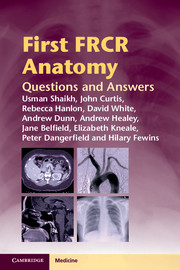Examination 6
Published online by Cambridge University Press: 05 March 2012
Summary
Sagittal CT ankle
Posterior sub-talar joint (PSTJ). The PSTJ is a synovial joint formed by the articulation of the posterior articular facets of the talus and calcaneum. Intra-articular extension into the PSTJ is often seen in comminuted calcaneal compression fractures and represents an important factor in the surgical classification of these injuries.
Cuboid. The cuboid possesses a proximal articular surface that only articulates with the calcaneum. Distally the cuboid articulates with the fourth and fifth metatarsals.
Neck of the talus. The talar neck is an important review area when evaluating ankle radiographs and CT in the setting of trauma. Missed talar neck fractures can result in avascular necrosis of the talar dome due to its blood supply being derived from vessels that enter the talar head and travel proximally within the neck.
The sinus tarsi. This is a fatty space beneath the talar neck and above the calcaneal body. The sinus tarsi also contains the cervical and interosseous ligaments along with traversing nerves and vessels. Inflammation and cyst formation in this space following trauma may produce a painful ‘sinus-tarsi syndrome’.
Os trigonum. This is present in 10% of individuals and when present, is bilateral in 50%. It may be present as a separate ossicle or be partly fused with the posterior talar process forming a synchrondrosis. The os trigonum may produce repetitive soft tissue impingment in the ankle due to repetitive plantar-flexion resulting in a painful ‘os-trigonum syndrome’.
Transverse ultrasound through stomach pylorus and upper abdomen
Rectus abdominus muscle.
Left lobe of liver.
Portal vein.
Aorta.
Pylorus.
- Type
- Chapter
- Information
- First FRCR AnatomyQuestions and Answers, pp. 161 - 166Publisher: Cambridge University PressPrint publication year: 2012



